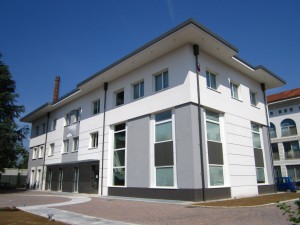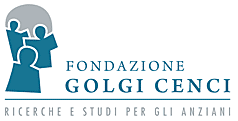 Dal 2013 piena attività della nuova sede del centro di ricerca sulla malattia di Alzheimer e altre demenze e l’invecchiamento cerebrale.
Dal 2013 piena attività della nuova sede del centro di ricerca sulla malattia di Alzheimer e altre demenze e l’invecchiamento cerebrale.
Da gennaio 2013 il centro è pienamente operativo in tutte le sue compenenti nella sede di corso San Martino 10.
L’urgenza assoluta della ricerca di nuove cure per la malattia di Alzheimer e delle altre forme di demenza è stata sottolineata proprio pochissimi giorni fa, l’11 aprile, dall’Organizzazione Mondiale della Sanità (OMS) e dall’Alzheimer’s Disease International (ADI) nel rapporto Demenza: una priorità di salute pubblica:
«Con il loro impatto devastante sulle persone affette da demenza, le loro famiglie, le loro comunità e i sistemi sanitari nazionali, le demenze rappresentano non solo un problema di salute pubblica, ma anche un incubo sociale, fiscale ed economico. In tutto il mondo ogni 4 secondi nasce un nuovo caso di demenza. Questo è un tasso di crescita impressionante, pari a 7,7 milioni di nuovi casi ogni anno – le stesse dimensioni delle popolazioni della Svizzera e Israele. I nostri attuali sistemi sanitari non possono far fronte all’esplosione della crisi delle demenze, in quanto tutti noi viviamo più a lungo. Questo imminente disastro economico e del debito pubblico rappresenta una sfida sociale e sanitaria di prim’ordine».
Nel nostro paese il rischio di demenza per le persone con più di 65 anni è di 1 ogni 8 (12,5%), ma se consideriamo la classe di età che più sta crescendo in Italia, cioè gli over 85, arriviamo ad un rischio che riguarda 1 persona ogni 2,5 (40%).
Purtroppo non esiste oggi una cura farmacologica o biologica della malattia, ma solo alcuni farmaci in grado di alleviare temporaneamente i sintomi. La priorità diviene quindi la ricerca di nuove possibilità terapeutiche, accanto a un diverso programma d’intervento da parte del sistema sanitario nazionale che di fatto, in Italia, per ora ignora il problema (mentre altri paesi, come la Francia e il Regno Unito, hanno fatto importanti investimenti nel settore).
La vicenda della Fondazione Golgi Cenci e del nuovo Centro di ricerca che è stato inaugurato il 24 aprile, fortemente voluto dall’ASP Golgi Redaelli e dalla Fondazione Cenci Gallingani, rappresenta dunque una scommessa difficile: una sfida alla scarsità degli stanziamenti pubblici per promuovere la ricerca sull’Alzheimer.
La sfida nasce dalla fiducia nella possibilità di progredire nella comprensione della malattia, forti dei molti passi avanti già compiuti, nonostante tutto, proprio grazie alla ricerca italiana.
Oggi sappiamo che esiste una “malattia di Alzheimer senza demenza”, cioè una fase “silente” della malattia, di durata non breve, in cui vi sono danni biologici che però non comportano ancora una riduzione dell’autonomia. Ai fini terapeutici è importantissimo poter rilevare la malattia in questa fase, prima che abbia prodotto danni irreparabili.
Per questo la ricerca è oggi orientata prioritariamente a rilevare dei “marcatori biologici” nel liquor o nel sangue o attraverso le neuroimmagini (PET, RMN), che indichino chi è affetto in modo molto precoce, per poter attuare terapie altrettanto precoci.
L’edificio che si inaugura ad Abbiategrasso è una palazzina di tre piani, appositamente costruita, destinata a diverse attività di ricerca che si sviluppano sinergicamente su tre aree:
- il Settore clinico, epidemiologico-assistenziale, neuropsicologico (Piano terra)
- il Settore biologico-genetico (Primo piano)
- il Settore neuropatologico (Secondo piano)
E’ prevista in particolare la realizzazione di una “banca del cervello” che, sull’esempio delle molte già operanti all’estero, metta a disposizione della ricerca scientifica campioni di tessuto cerebrale di soggetti ben conosciuti e valutati in vita. Una catalogazione accurata dei pezzi conservati, secondo metodologie stabilite da linee guida internazionali, consentirà lo studio e lo scambio con altri centri simili sia in Italia che all’estero.
Finora l’invecchiamento cerebrale è studiato soprattutto in relazione alle malattie neurologiche che si manifestano con l’età (Alzheimer, Parkinson, vasculopatie cerebrali…). L’ambizione della nuova banca sta nella possibilità di raccogliere anche cervelli di persone classificabili come “normo mentali”, oggi quasi assenti in simili banche, utilissimi per poter confrontare e trarre conclusioni anche di ordine generale nello studio del rapporto tra morfologia, patologia e funzioni mentali.
La sfida è ambiziosa ma poggia su solide basi: è dal 2007 infatti che l’ASP Golgi Redaelli e la Fondazione Cenci Gallingani, dopo aver collaborato per anni proficuamente su iniziative comuni, hanno deciso di dare stabilità e continuità al loro sodalizio creando la Fondazione Golgi Cenci, esempio efficace di partnership pubblico-privato che ha, fra le sue finalità generali, quella di coniugare le domande e i bisogni provenienti dall’assistenza agli anziani con le istanze e gli obiettivi della ricerca sui processi patologici delle malattie neurodegenerative.
Unendo più campi di ricerca attorno al tema della demenze, la Fondazione è riuscita a realizzare un vero approccio multidisciplinare, con professionalità mediche, psicologiche, biologiche, neuropatologiche che affrontano e studiano le interazioni fra le variabili sociali, psicologiche, genetiche presenti nelle malattie legate all’invecchiamento cerebrale.
The Alzheimer’s disease, dementia and brain ageing research centre has been operating entirely at its new premises since the start of 2013.
The research centre has been operating entirely at its new premises in corso San Martino 10 since January 2013.
The extreme urgency of the need for new treatments for Alzheimer’s disease and other forms of dementia was underlined in a joint report, issued on 11 April 2012, by the World Health Organisation (WHO) and Alzheimer’s Disease International (ADI) entitled Dementia: A Public Health Priority:
«With its devastating impact on people with dementia, their families, their communities and national health systems, dementia represents not only a public health crisis but a social and fiscal nightmare as well. Around the world a new case of dementia arises every four seconds. That’s a staggering growth rate, equivalent to 7.7 million new cases of dementia every year – the same size as the populations of Switzerland and Israel. Our current health systems simply cannot cope with the explosion of the dementia crisis as we all live longer; this is as much an economic and fiscal disaster waiting to happen as it is a social and health challenge of the highest order.»
In Italy, the risk of dementia in the over-65s is one in eight (12.5%). However, in the country’s fastest-growing age group, i.e. the over-85s, the risk is one in every 2.5 (40%).
Unfortunately, there exists no pharmacological or molecular cure for dementia, only a few drugs that can temporarily relieve the symptoms. The search for possible new treatments is therefore a medical priority, which must be supported by the introduction, by the national health system, of a new plan of intervention. Indeed, to date, this problem been largely ignored by the Italian NHS, whereas countries such as France and the United Kingdom have invested heavily in dementia research and care.
Given the shortage of public funding for research into Alzheimer’s disease, the story of the Golgi-Cenci Foundation and the new research centre, which was officially opened on April 24, 2013 (a project strongly backed by ASP Golgi Redaelli and the Cenci-Gallingani Foundation), is thus one of a difficult challenge.
It was, nevertheless, a challenge that, confident in the possibility of furthering understanding of this disease and strengthened by the many advances already made, despite everything, by Italian research in this field, we felt ready to take on and win.
Today we know that there exists a condition termed “Alzheimer’s disease without dementia”, in other words a prolonged “silent” phase of the disease in which biological damage is present but has still to manifest itself in a reduction of the affected person’s autonomy. From the treatment perspective, it is crucial to detect the disease in this early phase, before the damage can no longer be compensated for.
For this reason, the priority of research is currently to identify “biological markers” of the disease. The detection of such markers, in cerebrospinal fluid or blood or on neuroimaging scans (PET, MRI), will allow affected individuals to be identified and started on therapies very early in the course of the disease.
The centre opened in Abbiategrasso is a purpose-built three-storey building where three research lines are being pursued in a synergistic fashion:
- Clinical/epidemiological/welfare/neuropsychological research (ground floor)
- Molecular and genetics research (first floor)
- Neuropathological research(second floor)
The centre is also setting up a “brain bank” modelled on the many already in operation in other countries. Its purpose is to provide scientific research with samples of brain tissue from individuals who, in life, were well-known and closely assessed. Careful cataloguing of the tissue samples stored in the brain bank, using methods laid down by international guidelines, will make it feasible to perform studies and exchanges with other similar centres, both in Italy and abroad.
To date, brain ageing has been studied above all in relation to the neurological diseases associated with advancing age (Alzheimer’s disease, Parkinson’s disease, cerebrovascular diseases, etc.). The peculiarity of this new brain bank project, however, is that it also aims to store brain tissue from individuals who may be classified as “mentally healthy”. At present, banks containing this kind of material are practically non-existent, even though they would be an extremely useful study resource, both for comparisons withdiseased brains and also for drawing conclusions, even of a general nature, on the relationship between brain morphology, pathology and mental function.
It is an ambitious undertaking but one that rests on solid foundations: indeed, it is already several years since, in 2007, ASP Golgi Redaelli and the Cenci-Gallingani Foundation, after years of working together successfully on joint initiatives, decided to confer stability and continuity on their relationship by creating the Golgi-Cenci Foundation, an excellent example of collaboration between the public and private sectors whose main aims include that of combining the needs of the geriatric healthcare sector with the requirements and objectives of research into the pathological processes underlying neurodegenerative diseases.
By combining several different research areas relevant to dementia, the Foundation has succeeded in creating a truly multidisciplinary approach in which professionals with specialist medical, psychological, biological, and neuropathological expertise are together engaged in assessing and studying the interactions between the social, psychological, and genetic factors that determine brain ageing-related disorders.

